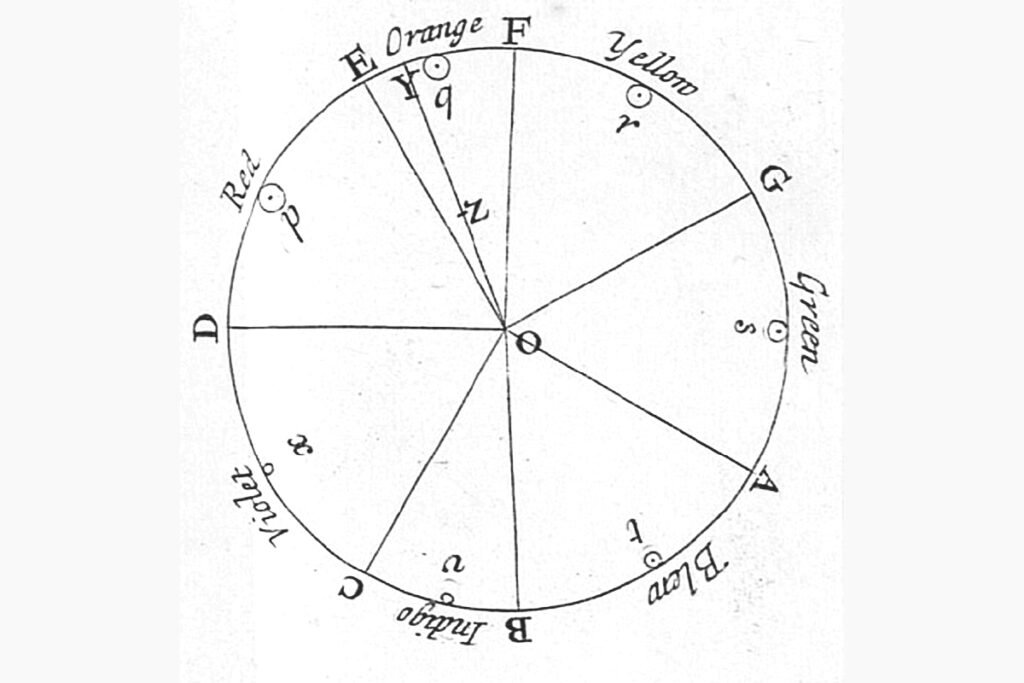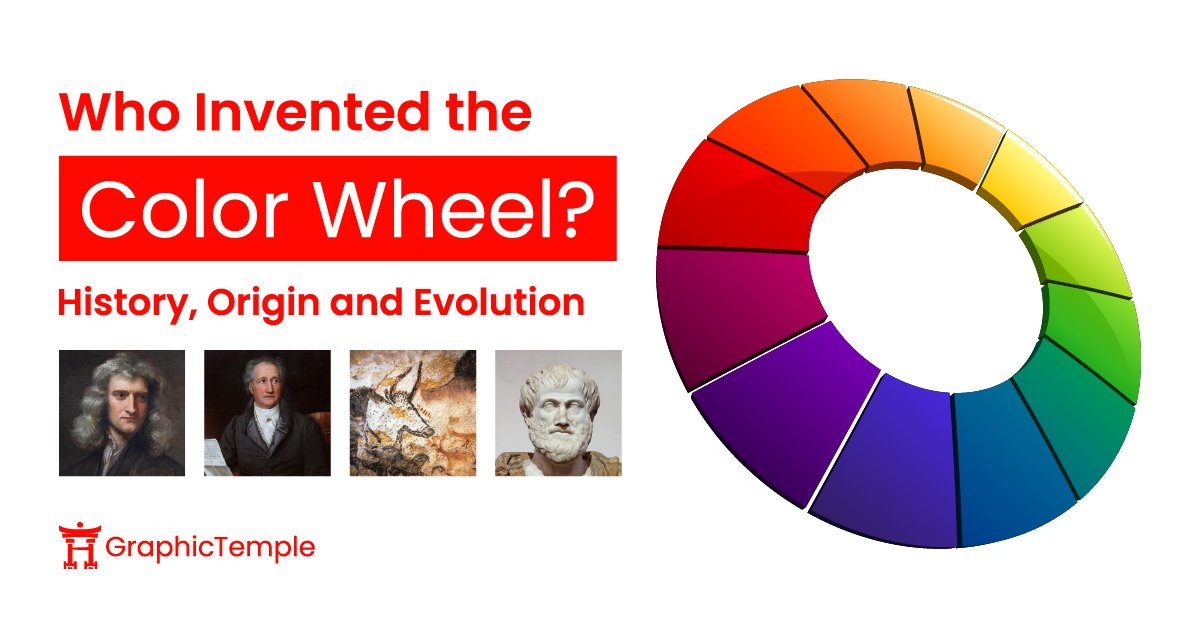Around 40,000 years ago, humans created the first pigments using natural materials found in their surroundings, producing colors like red, yellow, brown, black, and white. Since then, humans have discovered new pigments throughout various periods of history, driven by both exploration and scientific curiosity.
During that journey, inventing the color wheel was one of the landmarks in human understanding of color. If someone asks, “Who invented the color wheel?” The most straightforward and simplest answer is Sir Isaac Newton, the world-famous physicist conceptualized the color wheel and revealed that color is a property of light itself.
However, we are here to explore the evolution of human understanding of color, from the first human-made pigments to the modern RYB, RGB, and CMYK color models. Join me as we uncover how humans have developed color wheels to this day.
Table of Contents
01. The Birth of Color: When Humans First Created Pigments

Prehistoric humans invented the first pigments around 40,000 years ago. They created red, yellow, brown, black, and white pigments using a combination of burnt charcoal, soil, animal fat, and chalk. Early humans used those pigments for various purposes. Such as,
- Body painting & decorations: Archaeological research indicates that early humans used ochre and other minerals to adorn their bodies for ritual, identity, or social marking purposes.
- Cave paintings: The same natural pigments, such as ochre, charcoal, and chalk, first made by prehistoric humans, were used in cave paintings like Lascaux Cave (France), Chauvet Cave (France), the Cave of Altamira (Spain), and Cueva de las Manos (Argentina) to create vivid red, black, and yellow images nearly 17,000 years ago.
02. How Ancient Civilizations Gave Color a Meaning
Ancient civilizations, such as the Egyptians, Chinese, and Mesopotamians, used a diverse palette of natural pigments, including ochre, malachite, and lapis lazuli, to create a range of colors, including reds, yellows, greens, and blacks.
The ancient Egyptians used natural pigments to paint their famous tombs of pharaohs such as Tutankhamun, Seti I, and Ramses II, as well as to decorate royal clothing. They used vivid reds, blues, and golds in their art, as per their spiritual and cultural beliefs, giving those pigments a symbolic meaning.
In China, People invented dyes and pigments from materials such as indigo, cinnabar, and orpiment to bring life to their paintings, fabrics, and buildings.
The Mesopotamians used color as a medium of communication. Artists told the stories of their gods and kings using rich and bright pigments created from the cobalt-blue glaze of their ceramics, as well as the crimson dyes extracted from the Murex sea snail.
These ancient cultures left a lasting legacy that has shaped humans’ understanding of color, inspiring art and design today.
03. Aristotle’s Philosophy of Color
After ancient civilizations, the next major breakthroughs came with Greek philosophers. Among them, Aristotle was one of the first to share a structured view of color. He viewed color as a quality of a mixture of light and darkness (white and black). Even though his ideas weren’t scientific, they shaped the Western view of color for nearly 2000 years.
04. The Middle Ages
During the Middle Ages, people saw color through a more spiritual and artistic lens. It was guided more by religion and art than by scientific study, where color theory was a combination of symbolism, philosophy, and practical observation. Philosophers and thinkers of the time have explored the relationship between color and light. Figures like Roger Bacon tried to connect color with light and optics in the 13th century.
05. The Renaissance
The ancient color theory, which continued through the Renaissance, suggested that all colors were born from a blend of light and darkness(white and black).
However, in 1435, Leon Battista Alberti laid the theoretical foundation for modern color mixing and perspective. He was the first to suggest that red, yellow, and blue are the fundamental colors from which other colors are created. In the late 1400s, Leonardo da Vinci also explored color theory in his journals, expanding on how light and shadow influence the perception of color.
06. Sir Isaac Newton: Man Who Invented the Color Wheel for the First Time

Until his famous prism experiment, people mostly accepted that colors were a mix of light and dark (black and white). To prove this wrong, Sir Isaac Newton passed white light through a glass prism and observed red, orange, yellow, green, blue, indigo, and violet appearing on the wall. Today, these colors are better known as the colors of the visible spectrum. He later arranged these colors into a circular system, marking the invention of the first color wheel.

In the book he wrote in 1704, called “Opticks”, he introduced the first color wheel with the colors of the visible spectrum, which he found in his prism experiment, becoming the first to invent the color wheel. Interestingly, Newton’s color wheel contains absolutely no color at all, only the conceptual arrangement of colors derived from light.
Newton’s discoveries completely transformed the way we understand and use color scientifically, a foundation that continues to influence both art and science today.
07. Johann Wolfgang von Goethe’s Psychological Colour Wheel (1810)
While Isaac Newton is credited as the man who invented the color wheel through his scientific approach to understanding color, the German writer Johann Wolfgang von Goethe explored it from a more human and psychological perspective. Sharing his ideas in 1810, he published his influential book Theory of Colours, which is considered the first systematic study of the psychological impact of color.
Through his experiments, Goethe developed a color wheel with three primary colors: magenta, yellow, and blue, which he believed could be mixed to produce all other colors in the spectrum. Although his ideas were later surpassed by Newton’s scientific experiments, Goethe’s work remains essential because his studies highlight the cognitive effect that color has on human perception.
08. Albert H. Munsell’s Scientific Color Order System

Albert H. Munsell was the one who invented the color wheel that specifies colors based on the three independently varying properties of color. The color system was named after him. In his 1905 book “A Color Notation”, he introduced this three-dimensional color system. The Munsell color system uses a numerical scale to describe colors, with each color arranged in a clear and balanced manner, illustrating its relationship to all other colors.
- Hue (the actual color family: red, yellow, green, etc.)
- Value (lightness or darkness of the color)
- Chroma (the saturation or purity/intensity of the color)
It provides us with a scientific and consistent method of selecting and describing colors, bridging artistic intuition (hue choice) with technical accuracy (value & chroma).
09. Modern Color Wheels: The Foundation of Today’s Color Theory

Today, we have several widely accepted color wheels around the world, each designed for a different purpose.
- RGB Color Wheel: The RGB color wheel is used for light-based displays such as TVs, Digital cameras, and Computer monitors. It was based on the trichromatic theory by Thomas Young and Hermann von Helmholtz (early 19th century) and further extended by James Clerk Maxwell and others.
- CMYK Color Wheel: The CMYK color wheel is mainly used in printing & physical media. It uses a subtractive process of mixing inks to reproduce colour on paper, fabric, or any other printing platform. Jacob Christoph Le Blon laid the foundation for the CMYK color model. He developed a three-color printing process in the early 18th century. However,
- RYB Color Wheel: The RYB color wheel is the classic system used in traditional painting and design education. When discussing who invented the color wheel, the RYB model often comes up, even though it wasn’t introduced by a single person. It evolved over time through the work of several artists and theorists, with early concepts originating from thinkers such as Leonardo da Vinci, Claude Boutet, and Johann Wolfgang von Goethe. It was further developed by artists and designers such as Moses Harris, Johannes Itten, and Josef Albers.
- HSV/HSL color model: The HSV/HSL color models are used in digital design software and colour picker tools. Different people developed them in the late 1970s to make color selection more intuitive for computer graphics. Alvy Ray Smith was the first to describe the HSV model, while George Joblove first described the HSL model.
After centuries of discovery and experimentation, color has evolved into precise systems that guide how we see, reproduce, and use it in real-world applications today. Color wheels, such as RGB, CMYK, RYB, HSB, and HSL, are widely accepted across various industries. Each serves a unique purpose, helping us choose and apply color accurately within its own field. Today, they represent the reflection of humans’ centuries-long journey to understand and master color.
Think You Know the Color Wheel? Let’s Find Out!
01. Who first invented pigments?
Around 40,000 years ago, prehistoric humans created pigments in various colors, including red, yellow, brown, black, and white, using natural materials found in their surroundings.
02. Who viewed color as a mixture of light and darkness?
Aristotle was one of the first to view color as a quality of a mixture of light and darkness (white and black)
03. Who laid the theoretical foundation for modern color mixing and perspective?
Leon Battista Alberti was the first to suggest that red, yellow, and blue are the fundamental colors from which all other colors are created, laying the theoretical foundation for modern color mixing and perspective.
04. Who invented the color wheel first?
The most straightforward answer to the question “Who invented the color wheel?” is Sir Isaac Newton, the world-famous physicist who conceptualized the color wheel and revealed that color is a property of light itself.
05. Which book was the first to systematically study the psychological impact of color?
Johann Wolfgang von Goethe’s “Theory of Colours” was the first book to systematically study the psychological impact of color.
06. Who invented the color wheel that focused on the psychological impact of color?
The person who invented the color wheel, focusing on the psychological impact of color, was Johann Wolfgang von Goethe. His 1810 book, “Theory of Colours,” is considered the first systematic study of the psychological effects of color.
As we conclude this guide on the history and evolution of the color wheel, we hope you have found answers to all your questions, from who invented the color wheel to how modern color models work, and much more.
If you still have questions, feel free to leave a comment or send us a message. We’d be happy to help.



Pingback: What Is Value in Color Theory? Understanding Lightness and Darkness in Design - Graphic Temple